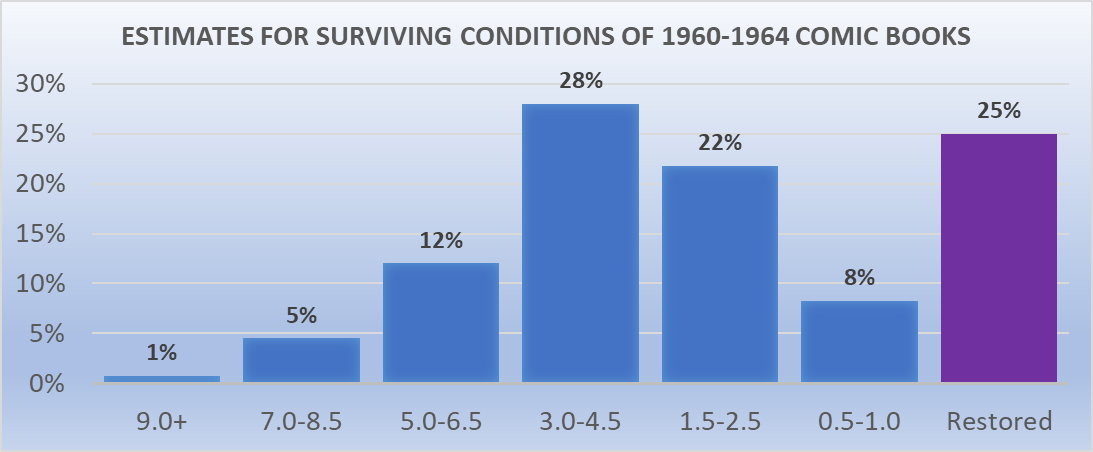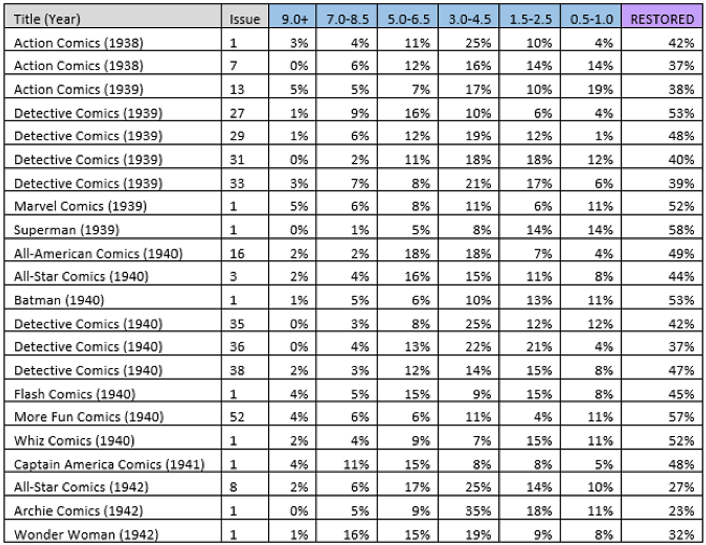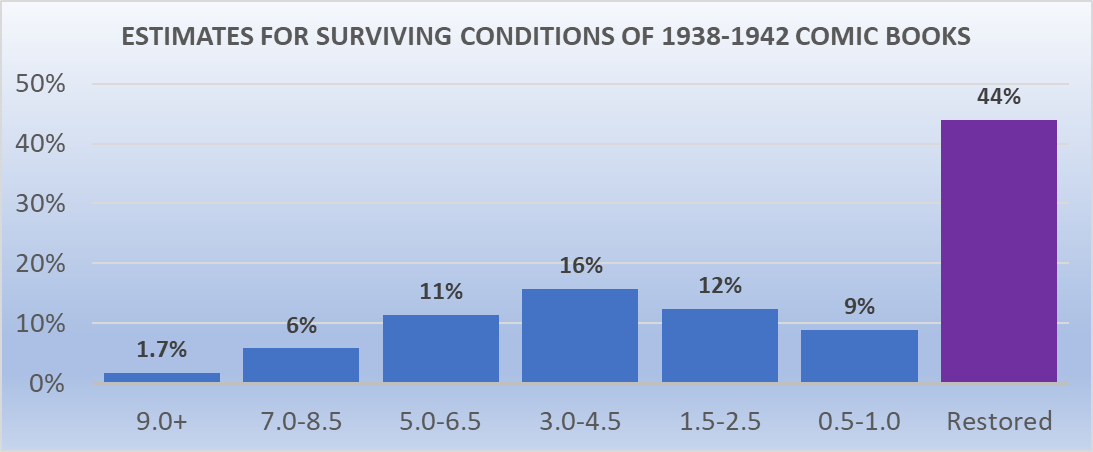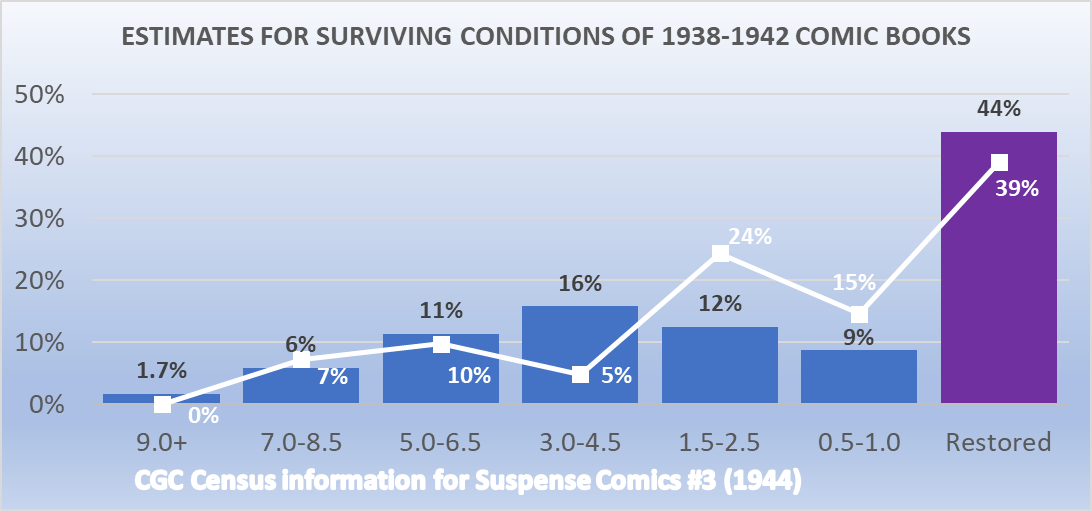From Action Comics #1 to early Silver Age – What’s Worth Slabbing in Poor Condition?
This article is Part 4 in a continuing series. Part 1, Part 2, and Part 3 are linked. In previous articles, it was established that books like Amazing Fantasy #15 (1962), Incredible Hulk #1 (1962), and Fantastic Four #1 (1961) – which are submitted to CGC in all conditions - provide a better representation of what conditions might be expected to exist for other comic books of the same age, even if they are never submitted to CGC. Additionally, the percentage of restored books on the CGC Census may be representative of the time period, reflecting attempts to improve a comic’s appearance over the past six decades.

Low Condition – High Value
Amazing Fantasy #15, Incredible Hulk #1, and Fantastic Four #1 have each been submitted to CGC in all conditions as a result of the market value for even the lowest graded copies of these issues. All three books have sales for CGC 1.0 approaching or exceeding $5,000, according to GPAnalysis.com (GPA).
Any comic, of any age, which has reached $5,000 in CGC 1.0 condition would be a good candidate to evaluate in the CGC Census as more representative of the surviving conditions of all comic books from their respective time periods.
Years 1938-1942
According to GPA, there are 22 comic books which have had at least two sales of $5,000 or more for CGC grade 1.0 or 0.5, not including Amazing Fantasy #15, Incredible Hulk #1, and Fantastic Four #1. These books have a financial incentive for submission to CGC in all grades to determine restoration. All 22 of these comic books are from 1938-1942.
Comic books with GPA recorded sales of $5,000+ at CGC 1.0 condition (or lower).

Combining the CGC Census data for all 22 from 1938-1942 books results in the chart below.

1944 to 1956 – Five More Books
Looking at the years between 1943 and 1959, there are currently only 5 comic books with GPA recorded sales above $1,000 for CGC 0.5 condition for the years 1944 to 1956. These middle-year books may provide some evidence for the surviving conditions and restoration percentages of comic books between the 1938-1942 and the 1960-1964 groupings evaluated thus far. It should be noted that the lowest conditions of these five books have not held values as high as the other books studied, and it is unlikely that all of the lowest conditions are well-represented on the CGC Census. Additionally, restored copies would be unlikely to be submitted as often as unrestored copies, given the lower values associated with restored copies.

These five books span more than a decade, so the comics identified will be evaluated separately by age.
First, notice that Suspense Comics #3 (1944) percentages do look quite similar to the 1938-1942 estimates for groupings from CGC 5.0 to 9.0+ and percent restored. Also notice that the CGC 0.5-1.0 and CGC 3.0-4.5 groupings appear to be reversed, and there the percentage of CGC 1.5-2.5 is double (24% compared to 12%).

Because the CGC Census for Suspense Comics #3 (1944) is just 41 total copies graded, any individual copy of Suspense Comics #3 (1944) represents 2.4% of the values in this chart. If only two or three copies in the CGC 1.5-2.5 range were graded instead as CGC 3.0, all the results would be very similar to the 1938-1942 estimates. Another possibility is that restoration removal for mid-grade restored copies could result in a higher percentage of CGC 0.5-2.5 universal grades. Suspense Comics #3 (1944) is not a perfect match to the 1938-1942 surviving condition estimates, but it is not a strong indicator for problems with those estimates either.
The next three books are from 1948-1951, Detective Comics #140 (1948), Phantom Lady #17 (1948), and Detective Comics #168 (1951). These three books have been submitted to CGC in totals of 183, 106, and 158 copies, respectively. All three of these books have lower value than both Suspense Comics #3 (1944) and Showcase #4 (1956) on either side of the 1944-1956 time period.

As a result of lower values for these three books, existing higher grade copies are more likely to have been submitted to CGC thus far, and fewer low grade copies (and fewer restored issues) would be expected on the CGC Census. While these limitations may be too great to rely upon these three books as evidence for all surviving conditions, the comparison to other estimates may provide insight into the likely grades of these books (and others in this time period) which are still available in raw (non-CGC graded) condition.
The final book of the five selected from 1944-1956 is Showcase #4 (1956). The significance of Showcase #4 is often compared to Fantastic Four #1 and Amazing Fantasy #15. The CGC Census would be expected to bare a close resemblance to the estimates for 1960-1964, with perhaps a higher restoration percentage if the 44% restored for 1938-1942 is indicative of more restoration when moving further back in time. Showcase #4 is four to eight years older than the 1960-1964 estimates with 25% restored.

The restored percentage for Showcase #4 is slightly higher than 25% for 1960-1964 at 29% for 1956, which seems perfectly in line with an estimate of 44% restored for comics from 1938-1942. There is also quite a bit of similarity between the CGC Census for Showcase #4 and the estimates for 1960-1964, with the only notable exception being the higher percentage of CGC 5.0-6.5 and lower percentages of CGC 0.5-4.5.
Bringing It All Together – 1938 to 1964
As a result of all the analyses thus far, it may be fair to estimate the surviving conditions of comic books from 1938 to 1964 as:

These estimates are certainly subject to revision as more information is presented in the years to come. The financial incentive to submit all conditions to CGC has only occurred for a few dozen comic books from these years at this point. There remains the potential that CGC submissions may shift toward more low-grade and restored books than anticipated if market values continue to rise for a wider variety of issues.
Whenever the CGC Census deviates significantly from these estimated percentages for a particular comic, any (or all) of the following possibilities may be applicable:
- The value of lower condition copies does incentivize CGC grading as a necessary expense
- The surviving copies were greatly impacted by a bundle/quantity surviving together
- The number of CGC graded copies to date is very low (fewer than 25)
- Unrecorded re-submissions may inflate the CGC Census
- A very low number in existence may be held by collectors who do not utilize CGC
There is certainly still a lot to learn about the comic book industry and about the surviving conditions of comic books, but the information available to us at this point in time does provide some insight that may have been difficult to articulate and quantify in the past. This series of articles for GPAnalysis.com will continue to poke and prod at the available data, with hopes of finding additional evidence for the industry.
About the Author
 |
Greg Holland has collected comic books for over 30 years and has been the administrator of the CGC Census Analysis website since 2003, currently located at CGCdata.com. He is the 1999 founder of the ValiantComics.com website and the 2004 ValiantFans.com message board. Dr. Holland holds a Ph.D. in information quality from the University of Arkansas at Little Rock and has held data science positions as research director, analyst, and administrator for government, corporations, and university. Active on the CGC Forums as ‘valiantman’ since 2002, he is also a 15+ year advisor to the Overstreet Comic Book Price Guide and contributor to later editions of the Standard Catalog of Comic Books. Greg resides in Arkansas, USA, with his wife of 23 years and their daughter. |
Related news
24 Oct 2022
Canadian Price Variants (CPVs) and GPAnalysis.com Recorded Sales
With Canadian Price Variants recorded in GPAnalysis.com for decades, what can the data tell us about rarity and value when comparing against direct editions?
Read more26 May 2022
CGC Census - A Game for the Thousandth Collector
Imagine a game where 1,000 lucky comic collectors are awarded the best available copies of comic books from the CGC Census. Where would ticket #1,000 be for the earliest appearances of favorite characters? Some winning books may surprise you.
Read more